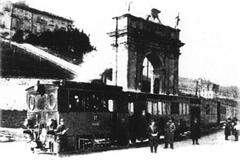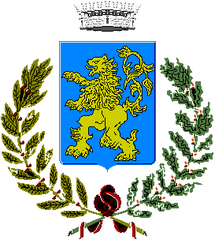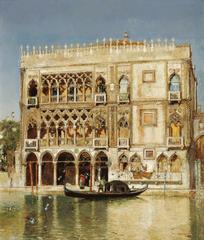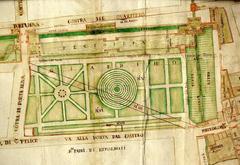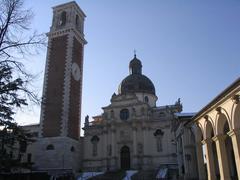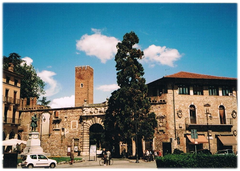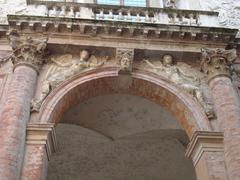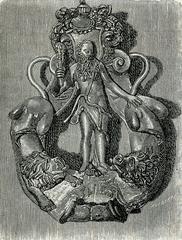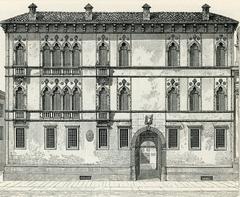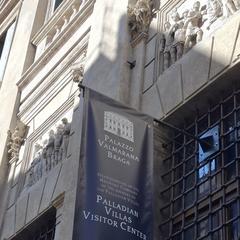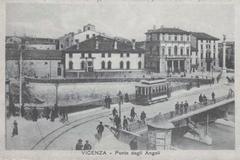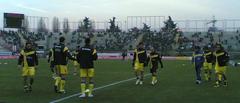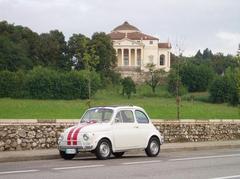Porta San Bortolo, Vicenza, Italy: Visiting Hours, Tickets, and Historical Sites Guide
Date: 03/07/2025
Introduction
Porta San Bortolo is a prominent historical gateway in Vicenza, Italy, representing centuries of urban evolution, defense, and civic life. Once a cornerstone of the city’s medieval fortifications and later a symbol of Renaissance transformation, it now stands as a testament to Vicenza’s adaptability and layered history. This guide offers a comprehensive overview of Porta San Bortolo, including its historical background, visiting hours, ticketing policies, accessibility, and nearby attractions. Whether you are a history enthusiast, architecture admirer, or a curious traveler, this guide will help you make the most of your visit to one of Vicenza’s most evocative historical sites.
Table of Contents
- Historical Overview
- Visiting Porta San Bortolo
- What to See
- Practical Tips
- Frequently Asked Questions (FAQ)
- Summary and Final Tips
- References
Historical Overview
Medieval Origins and Strategic Role
Porta San Bortolo was constructed between the 12th and 14th centuries, forming part of Vicenza’s defensive walls. Strategically located on the city’s northern edge, the gate regulated access and protected against threats from the direction of Bassano del Grappa. Its name comes from the nearby Church and Monastery of San Bartolomeo (locally “San Bortolo”), which provided spiritual and practical support to travelers, reinforcing the gate’s dual military and religious importance (Wikipedia: Chiesa e monastero di San Bartolomeo).
Renaissance Transformations and Venetian Influence
Under Venetian rule from the early 15th century, Vicenza’s fortifications—including Porta San Bortolo—were adapted to new military and urban requirements. The Venetian Republic’s fiscal policies impacted monastic lands and altered the urban fabric. In the 16th century, heavy taxation led to the sale of monastic properties, subtly changing the surroundings of the gate (Wikipedia: Chiesa e monastero di San Bartolomeo). Although Porta San Bortolo is not a Palladian structure, its context in a city celebrated for harmonious Renaissance architecture adds to its historical resonance.
Suppression of Monasteries and Urban Reconfiguration
A significant turning point occurred in 1771 when the Venetian government suppressed smaller monasteries, including San Bartolomeo. The complex was repurposed as the Ospedale Grande degli Infermi e dei Poveri (Great Hospital for the Sick and Poor), marking the area as a hub for public welfare—a function the modern Ospedale Civile di Vicenza continues today (Wikipedia: Chiesa e monastero di San Bartolomeo).
Artistic Heritage and Dispersal
The suppression of the monastery led to the redistribution of its artworks. Some were transferred to the Museo Civico di Vicenza, while others went to nearby churches or the Basilica di Monte Berico (Wikipedia: Chiesa e monastero di San Bartolomeo). This dispersal reflects the broader secularization of Venetian ecclesiastical assets in the late 18th century.
Modern Urban Significance
Today, while the original gate structure is not fully preserved, Porta San Bortolo remains a key urban landmark. Its location is marked by the continued presence of the hospital and elements of the former monastic cloister. The area’s incorporation into Vicenza’s restricted traffic zone (ZTL) preserves its pedestrian-friendly environment and historic character (Comune di Vicenza ZTL). The gate’s story encapsulates the interplay between defense, religion, public health, and art that has shaped Vicenza for centuries.
Visiting Porta San Bortolo
Location and Accessibility
Porta San Bortolo is located in the northern district of Vicenza, easily accessible on foot from the city center in about 20 minutes or by public transport. Bus lines 3, 4, 30, 127, 141, and 142 connect the area with central Vicenza and the main train station (Idealista). Parking is available in residential streets, though limited during peak hours. The area is bicycle-friendly, with dedicated lanes and bike racks.
The ZTL (Zona a Traffico Limitato) restricts vehicle access to preserve the historic ambiance. Pedestrian and wheelchair access is excellent, with paved paths and ramps nearby (Comune di Vicenza ZTL).
Visiting Hours and Tickets
- Hours: Porta San Bortolo is an outdoor site accessible at any time, day or night.
- Tickets: No entry fee is required to visit. The area is a public space.
- Special Access: The adjacent Ospedale Civile di Vicenza (hospital) is not open for tours, but guided visits to the surviving cloister may occasionally be available during cultural events or by arrangement with local tourism offices.
Guided Tours
Local guides and tour operators frequently include Porta San Bortolo in their historical tours of Vicenza. Audio guides and mobile apps such as Audiala provide self-guided experiences. For current tour schedules, check the Vicenza Turismo Official Website or inquire at the main tourist office.
What to See
Architectural Features
Porta San Bortolo, rebuilt in 1435, features robust masonry and a rounded archway typical of 15th-century Venetian military design. Originally flanked by two “torrioncini” (small towers), one of which survives and has been recently restored, the gate reflects the evolution of city defenses (Gilberto Padovan Editore). The area once included a moat and additional towers, remnants of which can be traced in the urban landscape.
Nearby Attractions
- Parco Querini: A large city park with manicured lawns, a small lake, and a neoclassical temple, ideal for picnics and strolls (The Crazy Tourist).
- Teatro Olimpico & Basilica Palladiana: Both within walking distance, these UNESCO World Heritage sites are must-see examples of Palladian architecture.
- San Bortolo District: Features local eateries, shops, and the Ospedale San Bortolo hospital. Churches such as Cuore Immacolato di Maria host community events (UP Fuori Porta San Bortolo).
Practical Tips
- Best Time to Visit: Spring and autumn offer pleasant weather and greenery. The site is accessible year-round.
- Accessibility: The area is safe and family-friendly. Some uneven surfaces exist due to the historic nature.
- Restrooms: No public restrooms at the gate, but facilities are available in nearby parks, cafes, and the hospital (limited access).
- Dining: Traditional Venetian cuisine and modern Italian fare are available in the district’s osterias and trattorias.
- Events: Community festivals, religious celebrations, and concerts are organized throughout the year (UP Fuori Porta San Bortolo).
Frequently Asked Questions (FAQ)
Q: Are there any entry fees or tickets required to visit Porta San Bortolo?
A: No, it is an open-air, public site with free entry.
Q: What are the visiting hours?
A: Porta San Bortolo is accessible at any time.
Q: Are guided tours available?
A: Yes, local tourism offices and guides offer occasional tours. Audio guides are also available.
Q: Is the site accessible for visitors with disabilities?
A: The area is generally accessible, though some uneven surfaces are present.
Q: What is the best time of year to visit?
A: Spring and early autumn for pleasant weather and scenery.
Summary and Final Tips
Porta San Bortolo encapsulates Vicenza’s historical tapestry, connecting its medieval, Renaissance, and modern chapters. Its integration into the city’s historical circuit, proximity to top attractions, and inclusion in the ZTL ensure a pleasant, pedestrian-friendly experience (Vicenza Turismo; Comune di Vicenza ZTL). Guided tours, the Audiala app, and local events offer deeper engagement for all visitors.
For updated information, consult the Vicenza Turismo Official Website, UP Fuori Porta San Bortolo, or mobile apps dedicated to Vicenza’s heritage. Begin your exploration of Vicenza’s fascinating history at Porta San Bortolo—a gateway to both the city’s streets and its soul.
References and Further Reading
- Wikipedia: Chiesa e monastero di San Bartolomeo
- Vicenza Turismo Official Website
- Comune di Vicenza ZTL Information
- Mapcarta: Porta San Bortolo Vicenza
- PlanetWare: Vicenza Tourist Attractions
- Gilberto Padovan Editore: Porta Santa Croce
- Italy Heritage: Vicenza History
- ViaggiArt: Vicenza Walls and Architecture
- Antica Pusterla: Vicenza Defensive Gates
- UP Fuori Porta San Bortolo
